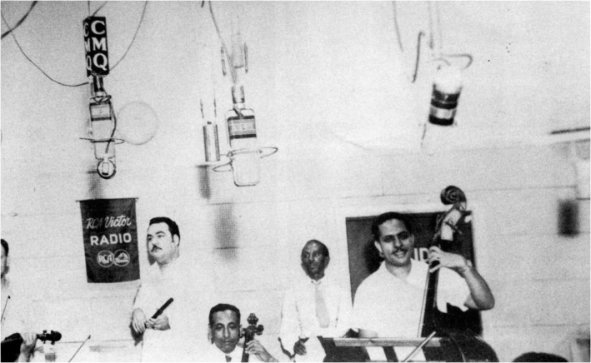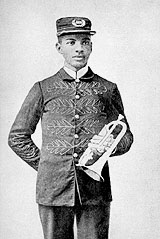|
Cuban Jam Sessions In Miniature
''Cuban Jam Sessions in Miniature'' is the debut album by Cuban double bassist Cachao, released in 1957 by Panart. The album is composed of descargas, improvised jam sessions with Cuban themes. It was the fourth installment in Panart's ''Cuban Jam Session'' series after Julio Gutiérrez's ''Cuban Jam Session Vol. 1'' and ''Vol. 2'', and Niño Rivera's ''Vol. 3''. Unlike the other installments, Cachao's session comprised short improvisations instead of extended jams. The album sold over a million copies and became "a Latin music milestone". In 2013, it was induced into the Latin Grammy Hall of Fame and the National Recording Registry. Background and recording Israel López, better known as Cachao, and his brother Orestes López, nicknamed Macho, were founding members of Cuba's most popular charanga during the late 1930s and 1940s, Arcaño y sus Maravillas, directed by flautist Antonio Arcaño. The repertoire of the group consisted almost exclusively of compositions by the López ... [...More Info...] [...Related Items...] OR: [Wikipedia] [Google] [Baidu] |
Cachao
Israel López Valdés (September 14, 1918 – March 22, 2008), better known as Cachao ( ), was a Cuban double bassist and composer. Cachao is widely known as the co-creator of the mambo and a master of the descarga (improvised jam sessions). Throughout his career he also performed and recorded in a variety of music styles ranging from classical music to salsa. An exile in the United States since the 1960s, he only achieved international fame following a career revival in the 1990s. Born into a family of musicians in Havana, Cachao and his older brother Orestes were the driving force behind one of Cuba's most prolific Charanga (Cuba), charangas, Arcaño y sus Maravillas. As members of the Maravillas, Cachao and Orestes pioneered a new form of ballroom music derived from the danzón, the danzón-mambo, which subsequently developed into an international genre, mambo. In the 1950s, Cachao became famous for popularizing improvised jam sessions known as descargas. He emigrated to Spa ... [...More Info...] [...Related Items...] OR: [Wikipedia] [Google] [Baidu] |
Mambo (music)
Mambo is a genre of Cuban dance music pioneered by the charanga Arcaño y sus Maravillas in the late 1930s and later popularized in the big band style by Pérez Prado. It originated as a syncopated form of the danzón, known as danzón-mambo, with a final, improvised section, which incorporated the ''guajeos'' typical of son cubano (also known as ''montunos''). These ''guajeos'' became the essence of the genre when it was played by big bands, which did not perform the traditional sections of the danzón and instead leaned towards swing and jazz. By the late 1940s and early 1950s, mambo had become a "dance craze" in the United States as its associated dance took over the East Coast thanks to Pérez Prado, Tito Puente, Tito Rodríguez and others. In the mid-1950s, a slower ballroom style, also derived from the danzón, cha-cha-cha, replaced mambo as the most popular dance genre in North America. Nonetheless, mambo continued to enjoy some degree of popularity into the 1960s and new ... [...More Info...] [...Related Items...] OR: [Wikipedia] [Google] [Baidu] |
Charlie Parker
Charles Parker Jr. (August 29, 1920 – March 12, 1955), nicknamed "Bird" or "Yardbird", was an American jazz saxophonist, band leader and composer. Parker was a highly influential soloist and leading figure in the development of bebop, a form of jazz characterized by fast tempos, virtuosic technique, and advanced harmonies. Parker was an extremely brilliant virtuoso and introduced revolutionary rhythmic and harmonic ideas into jazz, including rapid passing chords, new variants of altered chords, and chord substitutions. Primarily a player of the alto saxophone, Parker's tone ranged from clean and penetrating to sweet and somber. Parker acquired the nickname "Yardbird" early in his career on the road with Jay McShann. This, and the shortened form "Bird", continued to be used for the rest of his life, inspiring the titles of a number of Parker compositions, such as "Yardbird Suite", "Ornithology", "Bird Gets the Worm", and "Bird of Paradise". Parker was an icon for the hipster ... [...More Info...] [...Related Items...] OR: [Wikipedia] [Google] [Baidu] |
Dizzy Gillespie
John Birks "Dizzy" Gillespie (; October 21, 1917 – January 6, 1993) was an American jazz trumpeter, bandleader, composer, educator and singer. He was a trumpet virtuoso and improviser, building on the virtuosic style of Roy Eldridge but adding layers of harmonic and rhythmic complexity previously unheard in jazz. His combination of musicianship, showmanship, and wit made him a leading popularizer of the new music called bebop. His beret and horn-rimmed spectacles, scat singing, bent horn, pouched cheeks, and light-hearted personality provided one of bebop's most prominent symbols. In the 1940s, Gillespie, with Charlie Parker, became a major figure in the development of bebop and modern jazz. He taught and influenced many other musicians, including trumpeters Miles Davis, Jon Faddis, Fats Navarro, Clifford Brown, Arturo Sandoval, Lee Morgan, Chuck Mangione, and balladeer Johnny Hartman. He pioneered Afro-Cuban jazz and won several Grammy Awards. Scott Yanow wrote, "Dizzy ... [...More Info...] [...Related Items...] OR: [Wikipedia] [Google] [Baidu] |
Afro-Cuban Jazz
Afro-Cuban jazz is the earliest form of Latin jazz. It mixes Afro-Cuban clave-based rhythms with jazz harmonies and techniques of improvisation. Afro-Cuban music has deep roots in African ritual and rhythm.{{cite web, Cuba: Son and Afro-Cuban Music, https://worldmusic.net/blogs/guide-to-world-music/cuba-son-and-afro-cuban-music Afro-Cuban jazz emerged in the early 1940s with the Cuban musicians Mario Bauzá and Frank Grillo "Machito" in the band Machito and his Afro-Cubans in New York City. In 1947, the collaborations of bebop trumpeter Dizzy Gillespie and percussionist Chano Pozo brought Afro-Cuban rhythms and instruments, such as the tumbadora and the bongo, into the East Coast jazz scene. Early combinations of jazz with Cuban music, such as " Manteca" and "Mangó Mangüé", were commonly referred to as "Cubop" for Cuban bebop.{{cite book , last=Fernandez , first=Raul A. , title=From Afro-Cuban Rhythms to Latin Jazz , url=https://books.google.com/books?id=6WO7YevK_18C&pg=PA6 ... [...More Info...] [...Related Items...] OR: [Wikipedia] [Google] [Baidu] |
Bebo Valdés
Dionisio Ramón Emilio Valdés Amaro (October 9, 1918 – March 22, 2013), better known as Bebo Valdés, was a Cuban pianist, bandleader, composer and arranger. He was a central figure in the golden age of Cuban music, especially due to his big band arrangements and compositions of mambo, chachachá and batanga, a genre he created in 1952. He was the director of the Radio Mil Diez house band and the Tropicana Club orchestra, before forming his own big band, Orquesta Sabor de Cuba, in 1957. However, after the end of the Cuban Revolution, in 1960, Bebo left his family behind and went into exile in Mexico before settling in Sweden, where he remarried. His musical hiatus lasted until 1994, when a collaboration with Paquito D'Rivera brought him back into the music business. By the time of his death in 2013, he had recorded several new albums, earning multiple Grammy Awards. His son Chucho Valdés is also a successful pianist and bandleader. Biography Early career Bebo Valdés wa ... [...More Info...] [...Related Items...] OR: [Wikipedia] [Google] [Baidu] |
Norman Granz
Norman Granz (August 6, 1918 – November 22, 2001) was an American jazz record producer and concert promoter. He founded the record labels Clef, Norgran, Down Home, Verve, and Pablo. Granz was acknowledged as "the most successful impresario in the history of jazz"."Norman Granz" (obituary) '''', November 26, 2001 He was also a champion of racial equality, insisting, for example, on integrating audiences at concerts he promoted. Biography Born in Boyle Heights, Los Angeles, Granz was the son of |
Jazz
Jazz is a music genre that originated in the African-American communities of New Orleans, Louisiana in the late 19th and early 20th centuries, with its roots in blues and ragtime. Since the 1920s Jazz Age, it has been recognized as a major form of musical expression in traditional and popular music. Jazz is characterized by swing and blue notes, complex chords, call and response vocals, polyrhythms and improvisation. Jazz has roots in European harmony and African rhythmic rituals. As jazz spread around the world, it drew on national, regional, and local musical cultures, which gave rise to different styles. New Orleans jazz began in the early 1910s, combining earlier brass band marches, French quadrilles, biguine, ragtime and blues with collective polyphonic improvisation. But jazz did not begin as a single musical tradition in New Orleans or elsewhere. In the 1930s, arranged dance-oriented swing big bands, Kansas City jazz (a hard-swinging, bluesy, improvisationa ... [...More Info...] [...Related Items...] OR: [Wikipedia] [Google] [Baidu] |
Filin (music)
Filin ( es, filin) was a Cuban, but US–influenced, popular song fashion of the late 1940s to the early 1960s. The word is derived from ''feeling'', and is sometimes spelled ''filin'' or even ''el filin''. It describes a style of ''post-microphone jazz-influenced romantic song'' (~crooning). The Cuban roots of filin were in the bolero and the canción. It was related to the trova: in fact, filin was sometimes regarded as a renewal or reinvigoration, of the old trova. Some Cuban quartets, such as Cuarteto d'Aida and Los Zafiros, modelled themselves on U.S. close-harmony groups. Others were singers who had heard Ella Fitzgerald, Sarah Vaughan and Nat King Cole. Filin singers included César Portillo de la Luz, José Antonio Méndez, who spent a decade in Mexico from 1949 to 1959, Frank Domínguez, the blind pianist Frank Emilio Flynn, and the great singers of boleros Elena Burke and the still-performing Omara Portuondo, who both came from the Cuarteto d'Aida. A house in Hava ... [...More Info...] [...Related Items...] OR: [Wikipedia] [Google] [Baidu] |
Bolero
Bolero is a genre of song which originated in eastern Cuba in the late 19th century as part of the trova tradition. Unrelated to the older Spanish dance of the same name, bolero is characterized by sophisticated lyrics dealing with love. It has been called the "quintessential Latin American romantic song of the twentieth century". Unlike the simpler, thematically diverse ''canción'', bolero did not stem directly from the European lyrical tradition, which included Italian opera and canzone, popular in urban centers like Havana at the time. Instead, it was born as a form of romantic folk poetry cultivated by a new breed of troubadour from Santiago de Cuba, the ''trovadores''. Pepe Sánchez is considered the father of this movement and the author of the first bolero, "Tristezas", written in 1883. Originally, boleros were sung by individual ''trovadores'' while playing guitar. Over time, it became common for trovadores to play in groups as ''dúos'', ''tríos'', ''cuartetos'', etc ... [...More Info...] [...Related Items...] OR: [Wikipedia] [Google] [Baidu] |
Guaracha
The guaracha () is a genre of music that originated in Cuba, of rapid tempo and comic or picaresque lyrics. The word had been used in this sense at least since the late 18th and early 19th century. Guarachas were played and sung in musical theatres and in low-class dance salons. They became an integral part of bufo comic theatre in the mid-19th century. During the later 19th and the early 20th century the guaracha was a favourite musical form in the brothels of Havana. The guaracha survives today in the repertoires of some trova musicians, conjuntos and Cuban-style big bands. Early uses of the word Though the word may be historically of Spanish origin, its use in this context is of indigenous Cuban origin. These are excerpts from reference sources, in date order: A Latin American carol "Convidando esta la noche" dates from at least the mid 17th century and both mentions and is a guaracha. It was composed or collected by Juan Garcia de Zespedes, 1620-1678, Puebla, Mexico. This i ... [...More Info...] [...Related Items...] OR: [Wikipedia] [Google] [Baidu] |







